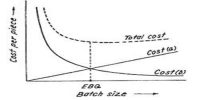Allocation and Apportionment of Overheads
Overheads are common costs incurred for the benefits of a number of costs centers or cost units. Therefore, they cannot be identified and allocated directly to a particular unit, of output. As such, they are to be allocated among the units of output of a particular department or a number of departments or cost centers.
Allocation is the process of identification of overheads with cost centers. Allocation of overheads is the process of charging overhead costs to a particular department or cost center. It is the allotment or assignment of an overhead cost to a particular cost unit. If the overhead cost is associated with a single department or cost center, the whole amount is charged or distributed among the units of output of that particular department. For example, the whole amount of repair and maintenance expenses for a machine is charged or allocated to that department where the machine has been installed.
Allocation of overhead is important for the following reasons:
- It helps to determine the product cost and fix the price of a product.
- It helps to measure the effectiveness of a particular department or cost center.
- It helps to evaluate the profitability of a product line in multi-product business.
- It helps to make accurate pricing for the competitive market.
- It can be used to control wastage and defective.
Distribution of an overhead cost to several departments or cost centers is known as apportionment of overheads. The term refers to the allotment of expenses which cannot identify wholly with a particular department. It is the process of charging or apportioning costs to a number of cost centers or cost units. If a given cost is common to two or more departments or cost centers, such cost should be apportioned or divided among these departments on an equitable basis. For example, the amount of factory rent should be apportioned to all the departments. Similarly, the amount of remuneration of the general manager should be distributed to the production, administration and marketing departments as the general manager is associated with all these departments.















